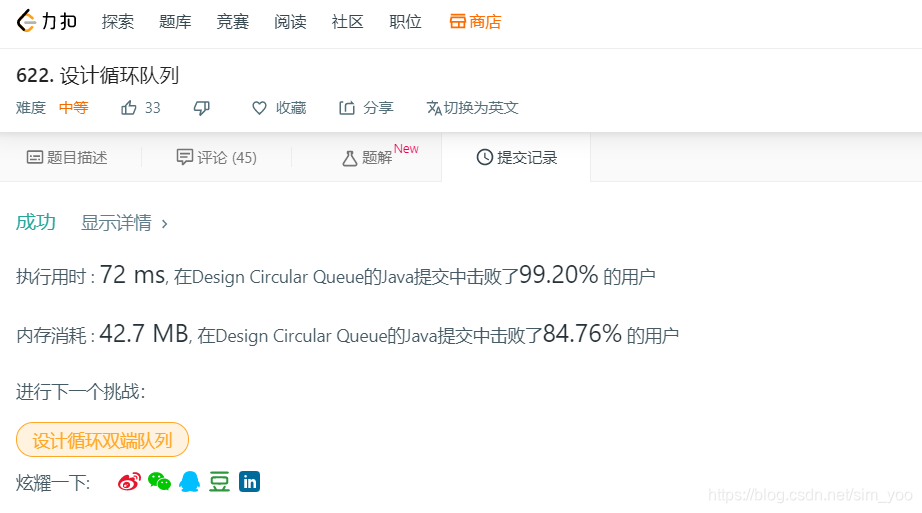队列简介
队列是一种先进先出(FIFO)的数据结构。
在 FIFO 数据结构中,将首先处理添加到队列中的第一个元素。
如上图所示,队列是典型的 FIFO 数据结构。插入(insert)操作也称作入队(enqueue),新元素始终被添加在队列的末尾。 删除(delete)操作也被称为出队(dequeue)。 你只能移除第一个元素。
队列的实现
为了实现队列,我们可以使用动态数组和指向队列头部的索引。
如上所述,队列应支持两种操作:入队和出队。入队会向队列追加一个新元素,而出队会删除第一个元素。 所以我们需要一个索引来指出起点。
这是一个供你参考的实现:// "static void main" must be defined in a public class. class MyQueue { // store elements private List<Integer> data; // a pointer to indicate the start position private int p_start; public MyQueue() { data = new ArrayList<Integer>(); p_start = 0; } /** Insert an element into the queue. Return true if the operation is successful. */ public boolean enQueue(int x) { data.add(x); return true; }; /** Delete an element from the queue. Return true if the operation is successful. */ public boolean deQueue() { if (isEmpty() == true) { return false; } p_start++; return true; } /** Get the front item from the queue. */ public int Front() { return data.get(p_start); } /** Checks whether the queue is empty or not. */ public boolean isEmpty() { return p_start >= data.size(); } }; public class Main { public static void main(String[] args) { MyQueue q = new MyQueue(); q.enQueue(5); q.enQueue(3); if (q.isEmpty() == false) { System.out.println(q.Front()); } q.deQueue(); if (q.isEmpty() == false) { System.out.println(q.Front()); } q.deQueue(); if (q.isEmpty() == false) { System.out.println(q.Front()); } } }
缺点
上面的实现很简单,但在某些情况下效率很低。 随着起始指针的移动,浪费了越来越多的空间。 当我们有空间限制时,这将是难以接受的。
让我们考虑一种情况,即我们只能分配一个最大长度为 5 的数组。当我们只添加少于 5 个元素时,我们的解决方案很有效。 例如,如果我们只调用入队函数四次后还想要将元素 10 入队,那么我们可以成功。
但是我们不能接受更多的入队请求,这是合理的,因为现在队列已经满了。但是如果我们将一个元素出队呢?
实际上,在这种情况下,我们应该能够再接受一个元素。
循环队列
设计循环队列
要求:
设计你的循环队列实现。 循环队列是一种线性数据结构,其操作表现基于 FIFO(先进先出)原则并且队尾被连接在队首之后以形成一个循环。它也被称为“环形缓冲器”。
循环队列的一个好处是我们可以利用这个队列之前用过的空间。在一个普通队列里,一旦一个队列满了,我们就不能插入下一个元素,即使在队列前面仍有空间。但是使用循环队列,我们能使用这些空间去存储新的值。
你的实现应该支持如下操作:
MyCircularQueue(k): 构造器,设置队列长度为 k 。
Front: 从队首获取元素。如果队列为空,返回 -1 。
Rear: 获取队尾元素。如果队列为空,返回 -1 。
enQueue(value): 向循环队列插入一个元素。如果成功插入则返回真。
deQueue(): 从循环队列中删除一个元素。如果成功删除则返回真。
isEmpty(): 检查循环队列是否为空。
isFull(): 检查循环队列是否已满。
示例:
MyCircularQueue circularQueue = new MycircularQueue(3); // 设置长度为 3
circularQueue.enQueue(1); // 返回 true
circularQueue.enQueue(2); // 返回 true
circularQueue.enQueue(3); // 返回 true
circularQueue.enQueue(4); // 返回 false,队列已满
circularQueue.Rear(); // 返回 3
circularQueue.isFull(); // 返回 true
circularQueue.deQueue(); // 返回 true
circularQueue.enQueue(4); // 返回 true
circularQueue.Rear(); // 返回 4
提示:
所有的值都在 0 至 1000 的范围内;
操作数将在 1 至 1000 的范围内;
请不要使用内置的队列库。
使用int[]实现循环队列的Java代码
代码如下
class MyCircularQueue {
private int[]myQye;
private int head;
private int tail;
private int capacity;
private int status = 0;
/** Initialize your data structure here. Set the size of the queue to be k. */
public MyCircularQueue(int k) {
myQye = new int[k];
head = 0;
tail = 0;
capacity = k;
}
/** Insert an element into the circular queue. Return true if the operation is successful. */
public boolean enQueue(int value) {
if (head==tail) {
if (status == 0) {
myQye[tail] = value;
tail++;
return true;
} else if (status == 1) {
return false;
}
} else if (head < tail) {
if (tail == capacity - 1) {
myQye[tail] = value;
tail = 0;
status = 1;
return true;
} else {
myQye[tail] = value;
tail++;
return true;
}
}
//此时head > tail
myQye[tail] = value;
tail++;
return true;
}
/** Delete an element from the circular queue. Return true if the operation is successful. */
public boolean deQueue() {
if (head == tail) {
//head == tail 说明该队列已经满了或者为空
if (status == 0) {
return false;
} else if (status == 1) {
//status为1表示该队列满了
if (head == capacity - 1) {
head = 0;
status = 0;
} else {
head++;
}
return true;
}
} else if (head < tail) {
head++;
return true;
}
//此时表示head > tail
if (head == capacity - 1) {
head = 0;
status = 0;
} else {
head++;
}
return true;
}
/** Get the front item from the queue. */
public int Front() {
if (isEmpty()) {
return -1;
}
return myQye[head];
}
/** Get the last item from the queue. */
public int Rear() {
if (isEmpty()) {
return -1;
}
if (tail == 0) {
return myQye[capacity - 1];
}
return myQye[tail - 1];
}
/** Checks whether the circular queue is empty or not. */
public boolean isEmpty() {
return head == tail && status == 0;
}
/** Checks whether the circular queue is full or not. */
public boolean isFull() {
return head == tail && status == 1;
}
}
/**
* Your MyCircularQueue object will be instantiated and called as such:
* MyCircularQueue obj = new MyCircularQueue(k);
* boolean param_1 = obj.enQueue(value);
* boolean param_2 = obj.deQueue();
* int param_3 = obj.Front();
* int param_4 = obj.Rear();
* boolean param_5 = obj.isEmpty();
* boolean param_6 = obj.isFull();
*/
运行结果








 本文介绍了队列的基本概念,强调了循环队列在空间效率上的优势,并详细阐述了如何使用Java数组实现循环队列,包括入队、出队等操作。同时,提供了具体的示例和代码展示。
本文介绍了队列的基本概念,强调了循环队列在空间效率上的优势,并详细阐述了如何使用Java数组实现循环队列,包括入队、出队等操作。同时,提供了具体的示例和代码展示。


















 5万+
5万+

 被折叠的 条评论
为什么被折叠?
被折叠的 条评论
为什么被折叠?








